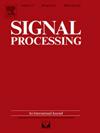A MISO acoustic echo cancellation algorithm based on a two-layer filter decomposition
IF 3.4
2区 工程技术
Q2 ENGINEERING, ELECTRICAL & ELECTRONIC
引用次数: 0
Abstract
The recursive least-squares (RLS) algorithm is a promising algorithm in acoustic echo cancellation (AEC) thanks to its fast convergence rate and competitive performance. However, its complexity is rather high, particularly when the system operates in acoustic environments with long acoustic impulse responses. This paper deals with the problem of AEC in a multiple-input and single-output (MISO) audio system, which consists of multiple loudspeakers and a microphone at the receiving room. A method is developed in the short-time-Fourier-transform (STFT) domain, which operates on a subband basis. In every STFT subband, the convolutive-transfer-function (CTF) model is adopted, so the echo path is modeled with a finite impulse response (FIR) filter. A two-layer decomposition (TLD) of the filter matrix is then applied and an RLS-type of algorithm is subsequently deduced to achieve channel identification and echo cancellation. This algorithm is able to achieve echo cancellation performance comparable to RLS algorithm with significantly lower complexity.
求助全文
约1分钟内获得全文
求助全文
来源期刊

Signal Processing
工程技术-工程:电子与电气
CiteScore
9.20
自引率
9.10%
发文量
309
审稿时长
41 days
期刊介绍:
Signal Processing incorporates all aspects of the theory and practice of signal processing. It features original research work, tutorial and review articles, and accounts of practical developments. It is intended for a rapid dissemination of knowledge and experience to engineers and scientists working in the research, development or practical application of signal processing.
Subject areas covered by the journal include: Signal Theory; Stochastic Processes; Detection and Estimation; Spectral Analysis; Filtering; Signal Processing Systems; Software Developments; Image Processing; Pattern Recognition; Optical Signal Processing; Digital Signal Processing; Multi-dimensional Signal Processing; Communication Signal Processing; Biomedical Signal Processing; Geophysical and Astrophysical Signal Processing; Earth Resources Signal Processing; Acoustic and Vibration Signal Processing; Data Processing; Remote Sensing; Signal Processing Technology; Radar Signal Processing; Sonar Signal Processing; Industrial Applications; New Applications.
 求助内容:
求助内容: 应助结果提醒方式:
应助结果提醒方式:


